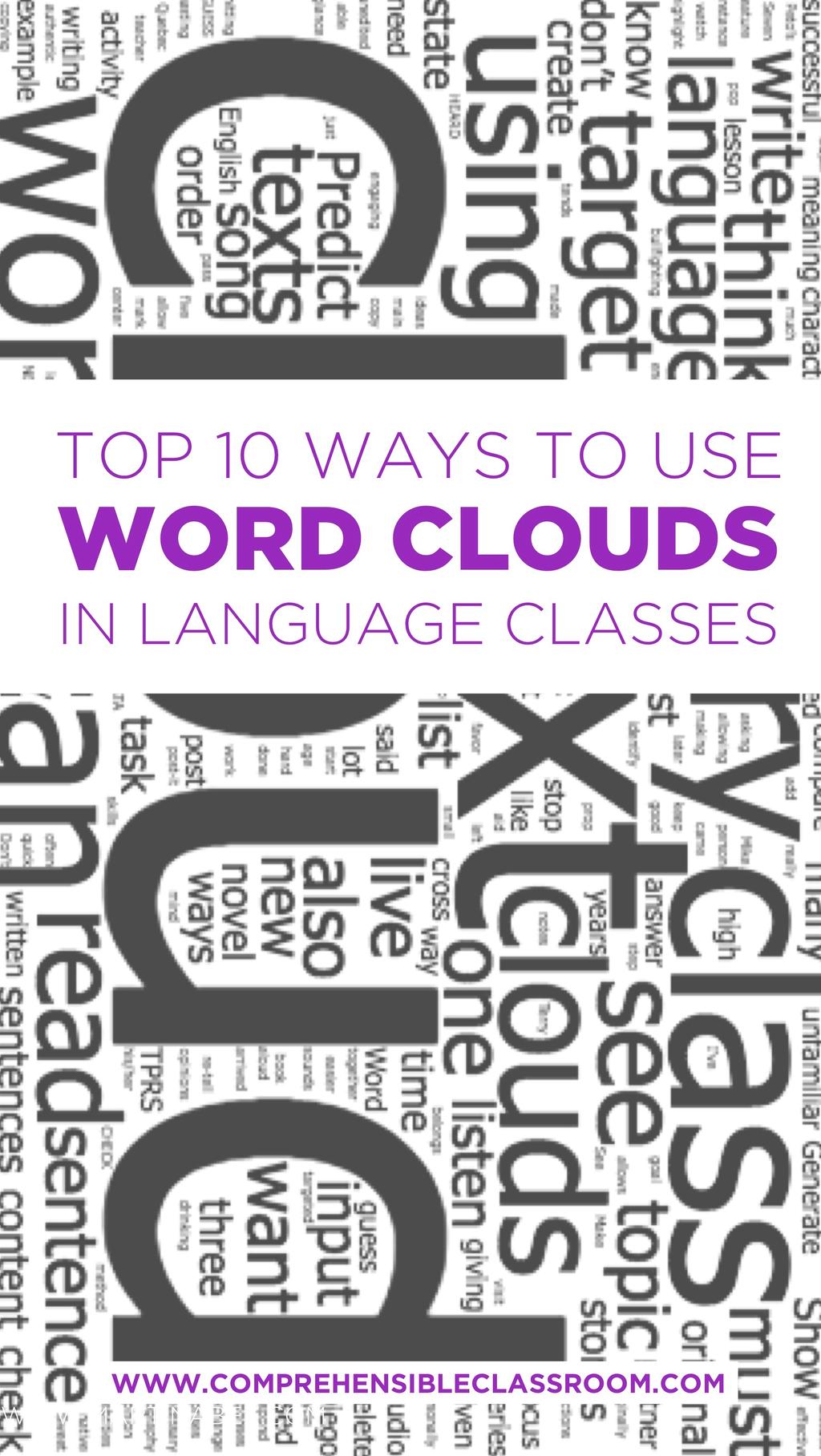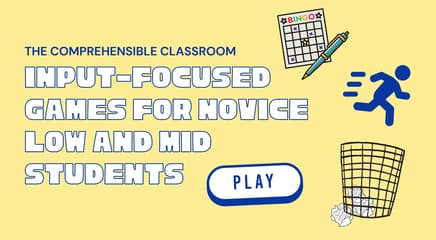I originally published this as a guest post the CI Peek blog--which gives you a PEEK into language teachers' classrooms from around the world with guest posts every Tuesday!
Word Clouds are everywhere. We see them in advertising, on merchandise, blog sidebar widgets, and—of course—instructional materials shared by teachers. Word clouds are a method of representing data in a visual way: specifically, the words contained within any given text and their frequency. The bigger the words appear, the more they are used in the text. For this reason, it is easy to see why TPRS®/CI teachers are so drawn to them! In general curriculum planning, we strive to target high frequency structures. When preparing students to read a text, we determine which words are most essential for students to know in order to understand it. And while word clouds are certainly helpful in lesson planning, there are also many, many ways that you can use them in class with your students!
Because we know that fluency improves through exposure to consistent, comprehensible input, our priority as language teachers is to provide input to our students that is both in the target language and understandable (comprehensible) to them. The use of word clouds should never detract from this purpose! I’ve compiled a list of ways that CI teachers can use word clouds to enhance instruction and engage students—just remember that word clouds will quickly lose their allure if overused! Don’t use a word cloud in every lesson, even if you are using them in different ways. So, without further ado…
MAKING PREDICTIONS
Before reading or listening to a text (such as a chapter from a Wayside Publishing novel, an article from a newspaper, or even a song!), copy and paste the text that students will read and/or listen to into a word cloud generator. Show the word cloud to students before reading or listening and have them make predictions. Here are some ideas:
- Predict the main idea of the text. What’s it about?
- Predict the who, what, where, when, why, and how of the text.
- Predict the five story elements: characters, setting, plot, conflict, and resolution.
- Predict whether or not they will enjoy the text, and explain why or why not.
PARTNER RACE
Put students in pairs and give each one a different colored highlighter or other writing utensil. (A) Read off the English translations of words from the cloud or (B) read sentences in the target language that contain word(s) from the cloud, and have students race their partner to see which one can circle or cross off (A) the target language equivalent of the English translation that you said or (B) any word(s) that they heard in the sentence that you read. See which partner can get the most words! I prefer to read sentences to students in the target language and have them mark off any words that they hear, also in the target language, so that the activity provides students with input. After any given sentence, you can stop and check for comprehension, clarify meaning, and personalize the content: just don’t let the “teaching” disrupt the flow of the game. Use enough sentences that are very familiar to students—sentences that you are certain that all students understand—that you don’t have to stop after each one in order to check for comprehension.
ORIGINAL STORIES
Generate a word cloud using a classic vocabulary list or an unfamiliar text. Then, have students write or tell a story using words from the cloud. Give them parameters such as “Use a minimum of 10 words from the cloud”, or “Use at least one new word from the cloud in each sentence”.
Similarly, you could have students write a cooperative story using the word cloud. One student in the class must write the first sentence of a story using at least 2 words from the cloud, then he or she passes the paper to a classmate. The second student continues the story with a second sentence, using at least two NEW words from the cloud. Continue to pass the papers to new students until they’ve written stories of a length that you desire. (Consider giving them a “start-wrapping-it-up” warning when there are only two or three exchanges left!)
TEXT COMPARISON
Choose two or more texts (familiar, unfamiliar, or a combination of the two) and generate word clouds from them. Show the word clouds to students and ask them to compare and contrast the texts based on the word cloud. This can be especially powerful with if you ask strategic questions that target higher order thinking skills, such as “Compare the perspectives on [topic x] shared in each of the texts”, or “The author of which text wanted to [purpose x]?” For a more simple task, you could simply ask students to state three similarities and three differences between the two texts.
PRESENTATIONAL ASSESSMENT AID
- On an assessment (formative or summative) that requires students to use the presentational mode, allow them to use a word cloud as support or as the task itself. Create the cloud using a list of familiar structures or with a text, and then have students reference the cloud as they complete the task. Here are some examples:
- Students must write a new version of a class story. They can use a word cloud of the original class story as a writing aid.
- Students are asked a series of randomly selected questions about a cultural topic that you’ve studied in class. They can reference a word cloud of the texts that you read in class about the subject while answering the questions.
- Students look at a word cloud created by inputting a text that supports one side of a controversial topic (like bullfighting, lowering the drinking age, etc.). Students must analyze the word cloud and state whether they think the author of the text is in favor of or against the topic and why they came to that conclusion (what evidence did the student see in the cloud that made them think that the author was for or against the topic?). This could also be done as a class discussion!
STORY EXCHANGE
Have students type original stories and then input them into word clouds.
- Each student must exchange the word cloud generated by his/her text with a classmate, and then the classmate must write the story that they think their classmate wrote.
- Project the word clouds one at a time to the class, and work together to orally re-tell the story that they think was originally written by the student
DATA ANALYSIS
An easy way to jump start a class discussion is to have students quickly respond to a question electronically or on post-it notes. An example is, “Where do you want to live in 25 years?”. Generate a word cloud from your students responses and show it to them. This gives you a ‘prop’ for discussion, making it easier to lead a successful conversation. You can ask questions that elicit students’ opinions and reactions to the word cloud (Which answer surprises you? Why do you think a lot of students want to live in [x] in 25 years? Why is [x] so small in the cloud [Why don’t many students want to live there?]). You can ask for volunteers to identify themselves and explain their answer (A lot of students want to live in Hawaii! Who said that they want to live in Hawaii? Why?), allowing you to further personalize the content. Because I personally have a hard time sustaining an engaging class discussion, I have found that finding or creating something physical—like a word cloud—to discuss leads to much more successful discussions!
CHECK YOURSELF
The goal of most CI teachers is to center their instruction on high frequency structures, often beginning with Terry Waltz’s Super Seven and continuing on to the remaining structures in Mike Peto’s Sweet Sixteen. For our curriculum to be most effective, we need to recycle previously targeted structures throughout the year. You can do a quick check to see if you are really doing this by updating a cumulative word cloud at the end of each class story: simply create a document that contains all class stories and texts that you’ve worked with to date, and pop it in a word cloud generator each time that you add a new story to it. You will be able to see at a glance which structures you are hitting regularly and which structures you are neglecting!
GUESS THE TEXT
Create a word cloud from a familiar text and show it to students: this could be a class story, a cultural reading, a song, or a chapter from a novel. Make them guess which text (which story, reading, song, chapter, etc.) is represented by the cloud! Then have them explain how they arrived at that conclusion. This is a great opportunity to have them practice giving evidence for an opinion or conclusion. You can also have them explain whether or not they think that the word cloud is a good representation of the text, and why!

WHO AM I?
Create a series of word clouds generated from the biographies of celebrities or even descriptions of characters from a familiar novel. You could do this by copying and pasting an authentic, unedited biography into the word cloud generator, or you could do it by using teacher or student-created descriptions of the celebrity. Show each word cloud to the class and have them guess to which celebrity it belongs! You could later analyze the text that was used to create the word cloud, but this step is not necessary. You can also extend the conversation by asking students to compare themselves to the subject of the word cloud, or to state whether or not they would like to be friends with that person, based on the content of the cloud. The word cloud that you see to here is about Diego Maradona, and I created it using http://www.wordclouds.com, which allows you to edit the word list after you enter the original text. That feature allowed me delete the words “Diego” and “Maradona” from the word cloud without having to go through the text beforehand and delete each individual instance.

I HEARD IT!
Create a word cloud for a text that students are going to listen to in class: it could be a chapter from an audio book read by a native speaker, a story that you are going to read aloud to your students, a song that you are going to listen to, or even the transcript of a commercial or short film that you are going to watch. As students listen to the audio text, have them cross off or highlight any words in the word cloud that they hear. This is a great activity to practice narrow listening, but keep in mind that it tends to focus students’ attention on the sounds of individual words and distract their focus from the meaning of the text.





